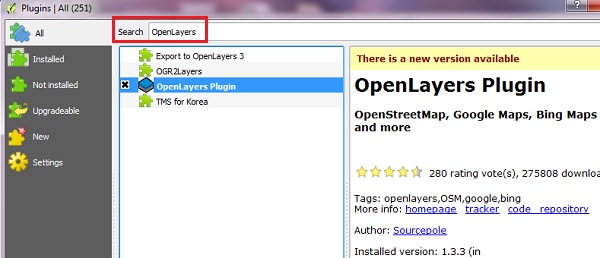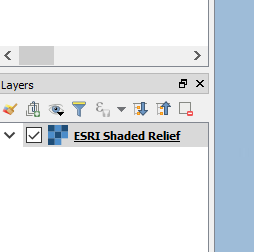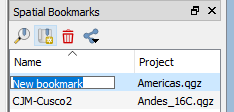Home
QGIS 1
Installing and Getting Started with QGIS
What is GIS and why use it?
Geographic Information Systems (or GIS) software is software for compiling, manipulating, and... yes... mapping spatial data. Everything happens somewhere, right? Thus, nearly every form of information - or "data" - has a spatial component to it. GIS allows us to compile, compare, analyze, and overlay the spatial nature of data.
QGIS is the most popular open-source GIS software and serves as an alternative to the commercial ArcGIS.
Key Resources
For additional information and tutorials see:
- Lessons on QGIS from The Programming Historian
- See also: The Geospatial Historian
- QGIS Tutorials
Mapping your hometown / neighborhood
For this tutorial, you will get started with QGIS by mapping your hometown (or for those of you from large cities: your home neighborhood).
I. Download and Install QGIS
- Set up your computer to run QGIS. You can either:
- Install QGIS from here. For more help on the installation process see The Programming Historian’s tutorial (review the section on installation).
- Or, link to GIS through a remote desktop (if available at your institution).
- Once QGIS is installed, open it and open a new project.
- Save the project, giving it a name like “[yourname]_[town/neighborhood]”.
II. Setup Coordinate System
- When starting a project in QGIS it is important to decide on a projection system before beginning. To view some global maps we will begin by using the “Pseudo-Mercator” projection as most web server maps we will import into QGIS use pseudo-Mercator as their default projections. In a subsequent lesson we will choose a more apt projection for looking at particular regions of the world.
- To set the projection:
- In QGIS, click on the Project menu and then select Properties.
- Select the CRS tab in the Project Properties window.
- Identify what the current Coordinate Reference system (CRS) is by looking at the “Selected CRS” box (the box below the "Predefined Coordinate Reference Systems" box).
- The default CRS is probably “WGS 1984.” To change it to Pseudo-Mercator type in “pseudo” in the filter bar. Hit enter. Now select the “WGS 84 / Pseudo-Mercator (EPSG:3857)” CRS. Press OK.
- To check the CRS close the Project Properties window. Now from the main QGIS window look at the information bar along the bottom right of the screen. There you will find some useful information (the current coordinate of your mouse, the scale, the degree of magnification and rotation, etc.). At the end you will also see the curent CRS. If its says EPSG:3857 then you have correctly set the projection as Pseudo-Mercator.

III. Create a Base Map
- In GIS, you may overlay a wide variety of different spatial layers from transportation networks to towns, and political and administrative borders. In most cases, you will want to begin with a base map. QGIS offers a plugin or add-on that allows you to use a variety of global and regional base maps. The instructions below explain how to import these base maps.
- From the main menu click Plugins -> Manage and Install Plugins
- Start for the word “Quick” in the SEARCH box to find the plugin “QuickMapServices.”
- Install QuickMapServices plugin.

- Now open the QuickMapServices plugin you just installed (Web –> QuickMapServices) to view all the available base maps to import into your QGIS project. You should see a list of about 20 data services, most providing multiple base map layers. This first time import ESRI’s Shaded Relief plugin.
- Now you have your first map layer in your project. Note, you should see the ESRI shaded relief layer in your Layer Window on the left side of your screen (if the Layer Window is not there, open it: View –> Panels –> Layers). You can then enable (check) and disable (uncheck) the layer as you see fit.

- You can add additional “base map” layers. However, note, these base maps layers work through a web service. Therefore, a) they won’t work when offline, and b) they can take up a lot of bandwidth so only have one base map layer enabled at a time.
IV. Find your way home (navigate)
Challenge: Using only the unlabeled ESRI shaded relief, try to navigate to your hometown. :
- You can navigate by:
- Using the pan symbol (hand) to pan across the map
- Using the magnifying glass (with a +) to zoom in and the magnifying glass (-) to zoom out.
- Using the magnifying glass (with arrows pointing outward) to zoom to full extent of the map.
- Using the magnifying glass (with a back arrow) to return to the previous view
- Pan and zoom in to the approximate location where you think your hometown is. Zoom to approximately a scale of 1:250,000 (see the Scale dropdown menu at the bottom of the screen)
- Now import another Web Map Layer to see if you are right:
- Web -> QuickMapServices
- Find and import:
- a road map (i.e. OSM -> OSM Standard)
- and a satellite map
- Disable the ESRI Shaded Relief layer and enable the new road map layer. Find the actual location of your hometown. How close were you to its correct location?
V. Set Spatial Bookmarks
It is useful to set a “spatial bookmark” to save particular views of your map layers. For example, you may choose to save one bookmark for your home state, one for your home county, and another for your hometown / neighborhood.To set your first spatial bookmark:
- Use the magnifying glasses with the + and - to zoom in and out to find the best view of your map layers.
- Once you found the best view of your map layers, save it your Spatial Bookmarks panel
- The Spatial Bookmarks panel should be open on the left side of the screen. If not, open it by enabling the Spatial Bookmarks panel: View–>Panels–>Spatial Bookmarks
- Save your current map extents to a bookmark by clicking on the New Spatial Bookmarks button (looks like a bookmark with a little yellow star).
- Give your new spatial bookmark a name (i.e. “[town name]”)
- Test it, using the hand symbol, pan to another part of the world. Then return to your saved view of the Americas by clicking on it within the Spatial Bookmarks panel.
- Now, practice creating several different spatial bookmarks, panning, zooming in, and zooming out over this map. In the next tutorial, we will learn how to add additional layers to your map.


VI. Create and Export a Map (the simple way)
Submit your completed map to your instructor by placing it in the "tutorial_submissions" folder within the class shared folder.